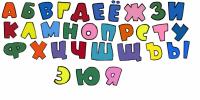Inequalities with roots are examples. Irrational inequalities
Goals:
- General education: to systematize, generalize, expand the knowledge and skills of students related to the application of methods for solving inequalities.
- Developing: to develop in students the ability to listen to a lecture, concisely writing it down in a notebook.
- Educational: to form cognitive motivation to study mathematics.
During the classes
I. Introductory conversation:
We have finished the topic “Solving irrational equations” and today we are starting to learn how to solve irrational inequalities.
First, let's remember what types of inequalities you can solve and with what methods?
Answer: Linear, square, rational, trigonometric. We solve linear ones based on the properties of inequalities, we reduce trigonometric ones to the simplest trigonometric ones, solved using a trigonometric circle, and the rest, mainly by the method of intervals.
Question: On what statement is the method of intervals based?
Answer: On a theorem stating that a continuous function that does not vanish on some interval retains its sign on that interval.
II. Let's consider an irrational inequality like >
Question: Is it possible to apply the interval method to solve it?
Answer: Yes, since the function y=- continuous on D(y).
We solve this inequality interval method .

Conclusion: we quite easily solved this irrational inequality by the interval method, actually reducing it to solving an irrational equation.
Let's try to solve another inequality with this method.


3)f(x) continuous on D(f)
4) Function zeros:

- Long search D(f).
- It is difficult to calculate breakpoints.
The question arises: “Are there other ways to solve this inequality?”.
Obviously, there is, and now we will get to know them.
III. So, topic today's lesson: "Methods for solving irrational inequalities."
The lesson will be held in the form of a lecture, since the textbook does not contain a detailed analysis of all methods. Therefore, our important task is to draw up a detailed summary of this lecture.
IV. We have already talked about the first method for solving irrational inequalities.
It - interval method , a universal method for solving all types of inequalities. But it does not always lead to the goal in a short and simple way.
v. When solving irrational inequalities, you can use the same ideas as when solving irrational equations, but since a simple verification of solutions is impossible (after all, solutions to inequalities are most often integer numerical intervals), it is necessary to use equivalence.
We present schemes for solving the main types of irrational inequalities method of equivalent transitions from one inequality to a system of inequalities.

2. It is proved similarly that

Let's write these diagrams on the reference board. Think about Type 3 and 4 proofs at home, we will discuss them in the next lesson.
VI. Let's solve the inequality in a new way.
![]()
The original inequality is equivalent to a set of systems.


VII. And there is a third method that often helps solve complex irrational inequalities. We have already talked about it in relation to inequalities with a modulus. it function substitution method (multiplier substitution). Let me remind you that the essence of the replacement method is that the difference in the values of monotonic functions can be replaced by the difference in the values of their arguments.
Consider an irrational inequality of the form<,
that is -< 0.
By theory, if p(x) increases on some interval to which they belong a and b, and a>b, then the inequalities p(a) – p(b) > 0 and a-b> 0 are equivalent to D(p), that is

VIII. We solve the inequality by the method of changing factors.

Hence, this inequality is equivalent to the system


Thus, we have seen that the use of the method of replacement of factors to reduce the solution of an inequality to the method of intervals significantly reduces the amount of work.
IX. Now that we have covered the three basic methods for solving equations, let's do independent work with self-examination.
It is necessary to perform the following numbers (according to the textbook by A. M. Mordkovich): 1790 (a) - solve_ by the method of_ equivalent transitions,_ 1791 (a) - solve by the method of replacing factors. To solve irrational inequalities, it is proposed to use the methods previously analyzed when solving irrational equations:
- change of variables;
- use of ODZ;
- use of monotonicity properties of functions.
The completion of the study of the topic is a test.
Analysis of the control work shows:
- typical errors of weak students, in addition to arithmetic and algebraic ones, are incorrect equivalent transitions to a system of inequalities;
- the method of substitution of factors is successfully used only by strong students.
Goals:
- General education: to systematize, generalize, expand the knowledge and skills of students related to the application of methods for solving inequalities.
- Developing: to develop in students the ability to listen to a lecture, concisely writing it down in a notebook.
- Educational: to form cognitive motivation to study mathematics.
During the classes
I. Introductory conversation:
We have finished the topic “Solving irrational equations” and today we are starting to learn how to solve irrational inequalities.
First, let's remember what types of inequalities you can solve and with what methods?
Answer: Linear, square, rational, trigonometric. We solve linear ones based on the properties of inequalities, we reduce trigonometric ones to the simplest trigonometric ones, solved using a trigonometric circle, and the rest, mainly by the method of intervals.
Question: On what statement is the method of intervals based?
Answer: On a theorem stating that a continuous function that does not vanish on some interval retains its sign on that interval.
II. Let's consider an irrational inequality like >
Question: Is it possible to apply the interval method to solve it?
Answer: Yes, since the function y=- continuous on D(y).
We solve this inequality interval method .

Conclusion: we quite easily solved this irrational inequality by the interval method, actually reducing it to solving an irrational equation.
Let's try to solve another inequality with this method.


3)f(x) continuous on D(f)
4) Function zeros:

- Long search D(f).
- It is difficult to calculate breakpoints.
The question arises: “Are there other ways to solve this inequality?”.
Obviously, there is, and now we will get to know them.
III. So, topic today's lesson: "Methods for solving irrational inequalities."
The lesson will be held in the form of a lecture, since the textbook does not contain a detailed analysis of all methods. Therefore, our important task is to draw up a detailed summary of this lecture.
IV. We have already talked about the first method for solving irrational inequalities.
It - interval method , a universal method for solving all types of inequalities. But it does not always lead to the goal in a short and simple way.
v. When solving irrational inequalities, you can use the same ideas as when solving irrational equations, but since a simple verification of solutions is impossible (after all, solutions to inequalities are most often integer numerical intervals), it is necessary to use equivalence.
We present schemes for solving the main types of irrational inequalities method of equivalent transitions from one inequality to a system of inequalities.

2. It is proved similarly that

Let's write these diagrams on the reference board. Think about Type 3 and 4 proofs at home, we will discuss them in the next lesson.
VI. Let's solve the inequality in a new way.
![]()
The original inequality is equivalent to a set of systems.


VII. And there is a third method that often helps solve complex irrational inequalities. We have already talked about it in relation to inequalities with a modulus. it function substitution method (multiplier substitution). Let me remind you that the essence of the replacement method is that the difference in the values of monotonic functions can be replaced by the difference in the values of their arguments.
Consider an irrational inequality of the form<,
that is -< 0.
By theory, if p(x) increases on some interval to which they belong a and b, and a>b, then the inequalities p(a) – p(b) > 0 and a-b> 0 are equivalent to D(p), that is

VIII. We solve the inequality by the method of changing factors.

Hence, this inequality is equivalent to the system


Thus, we have seen that the use of the method of replacement of factors to reduce the solution of an inequality to the method of intervals significantly reduces the amount of work.
IX. Now that we have covered the three basic methods for solving equations, let's do independent work with self-examination.
It is necessary to perform the following numbers (according to the textbook by A. M. Mordkovich): 1790 (a) - solve_ by the method of_ equivalent transitions,_ 1791 (a) - solve by the method of replacing factors. To solve irrational inequalities, it is proposed to use the methods previously analyzed when solving irrational equations:
- change of variables;
- use of ODZ;
- use of monotonicity properties of functions.
The completion of the study of the topic is a test.
Analysis of the control work shows:
- typical errors of weak students, in addition to arithmetic and algebraic ones, are incorrect equivalent transitions to a system of inequalities;
- the method of substitution of factors is successfully used only by strong students.
T.D. Ivanova
METHODS FOR SOLVING IRRATIONAL INEQUALITIES
CDO and NIT SRPTL
UDC 511 (O75.3)
BBC 22. 1Y72
Compiled by T.D. Ivanova
Reviewer: Baisheva M.I.– Candidate of Pedagogical Sciences, Associate Professor of the Department
Mathematical Analysis Faculty of Mathematics
Institute of Mathematics and Informatics of Yakutsk
state university
Methods for solving irrational inequalities: Methodological guide
M 34 for students in grades 9-11 / comp. Ivanova T.D. from Suntar Suntarsky ulus
RS (Y): TsDO NIT SRPTL, 2007, - 56 p.
The manual is addressed to high school students of a secondary school, as well as those entering universities as a methodological guide to solving irrational inequalities. The manual analyzes in detail the main methods for solving irrational inequalities, gives examples of solving irrational inequalities with parameters, and also offers examples for an independent solution. Teachers can use the manual as a didactic material for independent work, with an overview repetition of the topic “Irrational inequalities”.
The manual reflects the experience of the teacher in studying the topic "Irrational inequalities" with students.
The tasks are taken from the materials of entrance exams, methodical newspapers and magazines, textbooks, the list of which is given at the end of the manual
UDC 511 (O75.3)
BBC 22. 1Y72
T.D. Ivanova, comp., 2006.
CDO NIT SRPTL, 2007.
Preface 5
Introduction 6
Section I. Examples of solving the simplest irrational inequalities 7
Section II. Inequalities of the form  >g(x),
>g(x),  g(x),
g(x),  g(x) 9
g(x) 9
Section III. Inequalities of the form  ;
;
 ;
;
 ;
;
 13
13
Section IV. Inequalities containing several even roots 16
Section V. Substitution method (introduction of a new variable) 20
Section VI. Inequalities of the form f(x)  0; f(x)0;
0; f(x)0;
Section VII. Inequalities of the form  25
25
Section VIII. Using Radical Transforms
in irrational inequalities 26
Section IX. Graphical solution of irrational inequalities 27
Section X. Inequalities mixed type 31
Section XI. Using the monotonicity property of a function 41
Section XII. Function replacement method 43
Section XIII. Examples of solving inequalities directly
interval method 45
Section XIV. Examples of solving irrational inequalities with parameters 46
Literature 56
REVIEW
This manual is intended for students in grades 10-11. As practice shows, schoolchildren, applicants experience particular difficulties in solving irrational inequalities. This is due to the fact that in school mathematics this section is considered insufficiently, various methods for solving such inequalities are not considered more extensively. Also, school teachers feel the lack of methodological literature, which manifests itself in a limited amount of problem material with an indication of various approaches, methods of solution.
The manual considers methods for solving irrational inequalities. Ivanova T.D. at the beginning of each section introduces students to the main idea of the method, then examples are shown with explanations, and tasks are proposed for independent solution.
The compiler uses the most "spectacular" methods for solving irrational inequalities that occur when entering higher educational institutions with increased requirements for students' knowledge.
Students, having read this manual, can gain invaluable experience and skill in solving complex irrational inequalities. I believe that this manual will also be useful to mathematics teachers working in specialized classes, as well as developers of elective courses.
Candidate of Pedagogical Sciences, Associate Professor, Department of Mathematical Analysis, Faculty of Mathematics, Institute of Mathematics and Informatics, Yakut State University
Baisheva M.I.
FOREWORD
The manual is addressed to high school students of a secondary school, as well as those entering universities as a methodological guide to solving irrational inequalities. The manual analyzes in detail the main methods for solving irrational inequalities, gives exemplary patterns for solving irrational inequalities, gives examples of solving irrational inequalities with parameters, and also offers examples for an independent solution, for some of them short answers and instructions are given.
When analyzing examples, independently solving inequalities, it is assumed that the student is able to solve linear, square and other inequalities, owns various methods for solving inequalities, in particular, the method of intervals. It is proposed to solve the inequality in several ways.
Teachers can use the manual as a didactic material for independent work, with an overview repetition of the topic “Irrational inequalities”.
The manual reflects the experience of the teacher in studying the topic "Irrational inequalities" with students.
The tasks are selected from the materials of entrance exams to higher educational institutions, methodical newspapers and mathematics magazines "First of September", "Mathematics at School", "Quantum", textbooks, a list of which is given at the end of the manual.
INTRODUCTION
Irrational are inequalities in which variables or a function of a variable enter under the root sign.
The main standard method for solving irrational inequalities is to successively raise both parts of the inequality to a power in order to get rid of the root. But this operation often leads to the appearance of extraneous roots or even to the loss of roots, i.e. leads to an inequality that is not equivalent to the original one. Therefore, it is necessary to carefully monitor the equivalence of transformations and consider only those values of the variable for which the inequality makes sense:
if the root is of an even degree, then the radical expression must be non-negative and the value of the root must also be a non-negative number.
if the root of the degree is an odd number, then the radical expression can take any real number and the sign of the root coincides with the sign of the radical expression.
it is possible to raise both parts of the inequality to an even power only after first making sure that they are non-negative;
raising both sides of an inequality to the same odd power is always an equivalent transformation.
ChapterI. Examples of solving the simplest irrational inequalities
Examples 1- 6:

Solution:
1. a)  .
.
b)  .
.
2. a) 
b) 
3. a)  .
.
b)  .
.
4. a) 
b) 
5. a)  .
.
b) 
6. a)  .
.
b)  .
.
7.

8. a)  .
.
b) 
9. a)  .
.
b) 
11.

12. Find the smallest positive integer x that satisfies the inequality 
13. a) Find the midpoint of the solution interval of the inequality 
b) Find the arithmetic mean of all integer values of x for which the inequality has a solution of 4 
14. Find the smallest negative solution to the inequality 
15. a)  ;
;
b) 
Section II. Inequalities of the form >g(x), g(x),g(x)
Similarly, as in solving examples 1-4, we argue when solving inequalities of the indicated type.
Example 7
:
Solve the inequality  >
X + 1
>
X + 1
Solution: OHS inequalities: X-3. For the right hand side, there are two possible cases:
a) X+ 10 (the right side is non-negative) or b) X + 1
Consider a) If X+10, i.e. X- 1, then both parts of the inequality are non-negative. Let's square both sides: X
+ 3 >X +
2X+ 1. We get the quadratic inequality X+
X – 2
x x - 1, we get -1
+
2X+ 1. We get the quadratic inequality X+
X – 2
x x - 1, we get -1 
Consider b) If X+1 x x -3
Combining the solutions of the case a) -1 and b) X-3, write down the answer: X
 .
.
It is convenient to write all the arguments in solving Example 7 as follows:
The original inequality is equivalent to the set of systems of inequalities
 .
.




 X
X 

Answer: .
Reasoning when solving inequalities of the form
1.> g(x); 2. g(x); 3. g(x); 4. g(x) can be briefly written as the following diagrams:
I.
>
g(x)

2.
g(x)

3.
g(x)

4.
g(x)
 .
.
Example 8
:
 X.
X.
Solution:
The original inequality is equivalent to the system 

 x>0
x>0
Answer:
X
 .
.
Tasks for independent solution:

b) 

b)  .
.

b) 

b) 
20. a)  x
x
b) 
21. a) 
Any inequality, which includes a function under the root, is called irrational. There are two types of such inequalities:
In the first case, the root is less than the function g (x), in the second - more. If g(x) - constant, the inequality simplifies dramatically. Please note that outwardly these inequalities are very similar, but their solution schemes are fundamentally different.
Today we will learn how to solve irrational inequalities of the first type - they are the simplest and most understandable. The inequality sign can be strict or non-strict. The following statement is true for them:
Theorem. Any irrational inequality of the form
Equivalent to the system of inequalities:
Not weak? Let's look at where such a system comes from:
- f (x) ≤ g 2 (x) - everything is clear here. This is the original inequality squared;
- f(x) ≥ 0 is the ODZ of the root. Let me remind you: the arithmetic square root exists only from non-negative numbers;
- g(x) ≥ 0 is the range of the root. By squaring inequality, we burn the cons. As a result, extra roots may appear. The inequality g (x) ≥ 0 cuts them off.
Many students "go in cycles" on the first inequality of the system: f (x) ≤ g 2 (x) - and completely forget the other two. The result is predictable: wrong decision, lost points.
Since irrational inequalities are a rather complicated topic, let's analyze 4 examples at once. From elementary to really complex. All tasks are taken from the entrance exams of Moscow State University. M. V. Lomonosov.
Examples of problem solving
A task. Solve the inequality:
We have a classic irrational inequality: f(x) = 2x + 3; g(x) = 2 is a constant. We have:
Only two of the three inequalities remained by the end of the solution. Because the inequality 2 ≥ 0 always holds. Let's intersect the remaining inequalities:

So, x ∈ [−1,5; 0.5]. All points are shaded because inequalities are not strict.
A task. Solve the inequality:
We apply the theorem:
We solve the first inequality. To do this, we will open the square of the difference. We have:
2x 2 − 18x + 16< (x
− 4) 2 ;
2x 2 − 18x + 16< x
2 − 8x
+ 16:
x 2 − 10x< 0;
x (x − 10)< 0;
x ∈ (0; 10).
Now let's solve the second inequality. There too square trinomial:
2x 2 − 18x + 16 ≥ 0;
x 2 − 9x + 8 ≥ 0;
(x − 8)(x − 1) ≥ 0;
x ∈ (−∞; 1]∪∪∪∪)




